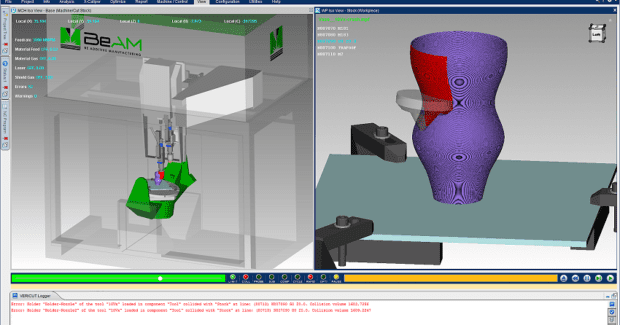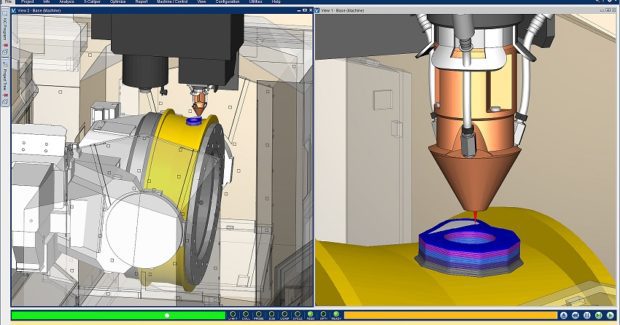Using Toolpath Simulation for Faster Build Rates of Extreme Complexity
BeAM uses software from CGTech to verify millions of lines of code used to drive their high-speed, five-axis powder-based directed energy deposition additive systems, creating a layer of machine protection and simulation accuracy otherwise impossible to achieve.
Posted: July 1, 2019
For as long as there has been additive manufacturing, design freedom has been one of the biggest cornerstones of its use. Because parts are produced one paper-thin layer at a time, there’s little that can’t be manufactured – all it takes is the ability to throw out conventional design-thinking in favor of a “let’s see what’s possible” mentality. This is particularly true when additive equipment has five-axis motion, is able to deposit a range of metals to existing workpieces, build completely from scratch and generate high quality parts with minimal post processing that is more cost efficient than traditional forms of manufacturing. Welcome to BeAM Machines Inc. (Cincinnati, OH), an original equipment manufacturer of powder-based directed energy deposition (DED) machines that utilize a high-powered laser and coaxial deposition nozzle to apply highly accurate, three-dimensional layers of aerospace-grade materials like titanium, Inconel, stainless steels, and more.
DED can be used to repair parts like turbine blades and fuel nozzles, add features to existing geometries, and build near-net-shape with “the best surface finish currently available from any metal-based additive manufacturer,” said Austin Kron, the business development manager of BeAM North American operations. “Not only is the machine extremely accurate, but having five-axis brings a great deal of flexibility to the table. For example, we can generate part features less than 1 mm thick, with better than 100 micron accuracy. This eliminates much of the post-process machining needed with virtually all metal parts. And unlike powder bed machines, we don’t need support structures during the build – we just rotate the part to whatever orientation is necessary to maintain proper geometry.” These five-axis capabilities allow users to take design freedom in ever more complex directions. However, even with the ability to create previously unachievable shapes, the BeAM has found visualization of these shapes increasingly challenging.
For this reason, the team at BeAM’s Cincinnati solutions center turned to VERICUT toolpath simulation provider CGTech Inc. (Irvine, CA) for help with verifying the millions of lines of code needed to drive their 3D printers. Using VERICUT toolpath simulation and optimization software with the VERICUT Additive module, they now have the ability to simulate all aspects of the 3D printing process and:
- Eliminate expensive machine downtime and scrapped workpieces by detecting collisions before they happen.
- Validate machine operating parameters such as gas flow, laser wattage, and proper material flow per material type.
- Maintain the entire part build history for troubleshooting purposes or for customer-mandated archiving.
- Clearly identify programming errors, as well as opportunities for process improvement.
- Provide realistic viewing of additive process, part build from it, and machine tool motion throughout the build process, long before the laser lights up or the powder begins to flow.
The software does all this by reading the same G-code data file that the machine uses. There are never translation errors and it doesn’t matter where the code came from, whether it was generated by a CAM system, a custom application, text editor, or composite from any of these means. “This Additive module uses a digital twin of the workpiece and machine tool to simulate 3D printing and hybrid processes,” explained CGTech product manager Gene Granata. “Because the software sees what the machine sees, it creates a layer of machine protection and simulation accuracy otherwise impossible to achieve. This is especially important with these high-speed five-axis DED machine tools due to the extreme part complexity and fast build rates made possible by the equipment.”
“VERICUT Additive has proven to be an extremely valuable tool for optimizing code,” noted Tim Bell, the engineering director at BeAM. “It’s certainly reduced the amount of time needed for process development, and its simulation capabilities have helped us detect and avoid costly collisions. What’s more, it can be used for calculating cycle times in advance of the actual build, determining part feasibility, and given us greater confidence with difficult geometries. I would strongly recommend this to any of our customers.”
VERICUT CNC machine simulation, verification and optimization software simulates all types of CNC machining, additive and hybrid manufacturing processes. The software operates independently, but can also be integrated with leading CAM systems. “With this software, NC programmers and planners are able to determine which additive equipment and build strategies work best,” added Granata. “By simulating real NC data on digital twin machines, it can prevent expensive crashes, identify conflicting setups and ensure additive functions are properly controlled by the NC program.” VERICUT 9.0 includes several advancements for additive manufacturing: Users can add material and cut via any traditional machining operation, in any desired order. Enhanced graphics provide sharper views of the additive processes and flexibility to rotate or zoom while simulating. Users can verify the entire manufacturing process and ensure 3D printed parts match engineered designs by simulating all machining setups, including post-process finishing. Analysis tools include the ability to section and measure additive parts, report on build times, and volumes of material used.
BeAM Machines Inc., 5101 Creek Road, Cincinnati, OH 45242, 513-745-4510, www.beam-machines.com.
CGTech, 9000 Research Drive, Irvine, CA 92618, 949-753-1050, info@cgtech.com, cgtech.com.





